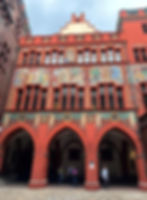Exploring Basel, Switzerland: A Fusion of Fountains, Artistic Wonders, and Culinary Delights
- Candace Ahlfinger
- Mar 11, 2024
- 3 min read
Updated: May 18, 2024

We arrived and walked…across the street to the Hotel Gaia. The hotel provided us with the Basel card which gives free public transportation and discounts for many museums. We quickly took the tram to the Tinguely-Brunnen Fountain, a fascinating modern fountain made from metal and plastic parts of the theater stage that once stood in the location. The parts spew out water in fascinating ways—architectural features shooting water from their eyes, anyone?

Next up was the Münsterplatz with its large open space and beautiful trees. Overlooking the platz is Basel Cathedral (Münster). The interesting crypt highlights ruins that were discovered during various renovations of the church.

Outside the church, we headed to the back of the cathedral and down—about 130 stairs—to the ferry across the Rhine River. This ferry isn’t the same old ferry. Instead, the old wooden vessel is tied to a rope tethered on both banks. The river’s current takes the ferry from side to side on a smooth new adventure—there is no external power. As in the 1800s when the ferries began, riders must pay in cash—but only 2 Francs for adults and 1 for children. We walked down to the colorful Town Hall (Rathaus) which sits on the Market Square where public announcements and executions were once held. (I’m not certain if these two types of events were connected or not.)

A meandering walk through some of the many shopping areas got us back to our hotel, dinner, and catching up with family who met us in Basel and needed some sleep to recuperate from their flight. (We actually caught the train to Lucerne the next day, but, for simplicity’s sake, I’ll continue our Basel visit here.)

Our visit to Basel continued at the Künstmuseum, an art museum that features such diverse artists as Picasso, Dali, and Kandinsky. (This multicultural city has 44 museums and 14 theaters which could keep you busy for a long time.)

We also took time to follow a guild band and parade through the city and find amazing street art.

One of our fun stops during our wanderings was at the Hoosesagg Museum, the smallest museum in Basel. This 2 foot by 2 foot window set in a 600-year-old building houses exhibits that change frequently. In fact, anyone with small pieces that meet the family’s requirements may be invited to exhibit.

Bistro Restaurant Schlüssel-Zunft provided an excellent upscale dinner for our last night in town. (The restaurant is located in a traditional guild house with a history back into the 1300s.)

A few notes about Basel:
Basel straddles three countries—France, Germany, and Switzerland. On the Dreiländerbrücke (Three Countries) Bridge you can be in three countries all at once. Four languages—German, English, French and Swiss German, which may not be understandable even if you speak German.
The Basel airport lies on the border of Switzerland and Germany. When you exit, you choose the door of the country you want to enter.
Basel is famous for pharmaceutical manufacturing. Originally, merchants in Basel had to buy silk ribbons from India. They decided to make the ribbon dyes themselves to save money and so began chemical companies.
Beggars are not allowed to stay overnight in Basel.
Basel is home to over 300 fountains.

At Basel, we caught the Viking Tialfi for a wonderful river cruise to Amsterdam...another great experience.
Follow our Viking River Cruise from Basel to Amsterdam by clicking here.
To see our info for our stay in Basel, Switzerland, click here.
For information about our day trip to Lucerne, click here.
Our Zurich experience is at this link.
For information about our time in Grindelwald and Bern, click here.
For info on our visit to Zermatt, Switzerland, click here.
Two Days in Amsterdam, click here.
I'd love for you to subscribe to my blog by entering your email on this page.




